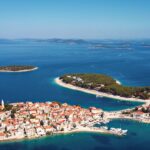Where to go & what to see is one of the main questions that we always ask ourselves when we visit a new place. Island Korcula offers many interesting sights and places but only to those who know where to look. With our tips all museum lovers can experience a journey that starts 20.000 years in a past with a Big cave, and ends in home of world known explorer Marco Polo. Hear our suggestions and find these museums that will fulfill your stay on Korcula.
1. Vela spila (Big cave) & Museum collection of Culture center (Vela Luka)
Situated on the west part of island Korcula, above the small town of Vela Luka, lays a hidden gem: Big cave. Scientific research of the cave started during the 1940s, and they are still going on, showing us that there was human presence going back 20 000 years. Between 1996. and 1998., in the deepest part of the cave, the graves of three children from the time around 7000 BC were found. These are also the oldest human burials in Dalmatia. Their position, which mimics the fetus in the womb, indicate the belief in rebirth. While Vela spila gives you an impress of where people used to live (an bury their dead), all archeological findings that describe how people have been living can be seen in Culture center in Vela Luka, located near the main church.
Tip: Vela spila is reachable both by car & marked hiking road.

Sneak peek to Vela spila: Inside of Vela spila
2. Ethnographic collection of olive growing and oil Zlokić (Vela Luka)
Korcula island has a thousand years rich tradition of viticulture and olive oil production, and many local families produce their own wine and oil. Extra virgin olive oil from island Korcula has won many prices and it is definitely something that every tourist should taste while visiting Korcula. Family Zlokic has a long tradition in the olive growing, and olive oil production, and it is one of the leading producers on the island of Korcula. In their collection Zlokic family has collected and exhibited wooden press for olives from 15th century, an old hydraulic system for compressing from the 18th century, grinding stones and other old-fashioned tools that were used hundreds of years ago in olive growing and oil industry.
Tip: Ethnographic collection is situated on the entrance to Vela Luka, right on the main road that goes to Blato.

3. Ethno Museum Barilo (Blato)
Ethno Museum Barilo offers a great island experience showing customs and everyday life of our ancestors. Museum is situated in house that belongs to family Marinovic that has been living here for many centuries, in center of Blato. Wondering about how life used to look like when our grandmas and great grandmas were young about 600 exhibits of this ethnographic collection will help you to take a walk through past and feel traditional island life which is already almost forgotten. The collection is organized in several exhibition areas like bedroom or kitchen and it has collection of traditional costumes, agricultural tools, fishing equipment and numerous objects for everyday use.
Tip: At the end of the tour you can taste some of the homemade products.

4. Korcula Town Museum (Korcula)
Korcula Town Museum is situated in Gabrielis Palace, opposite of the St. Mark’s Cathedral at St. Mark’s Square. Museum is small, but covers almost all important facts about Kočula`s history. It has collection that refers to Korcula’s cultural and historical heritage (archaeological objects, photographs…) from Ancient time to present. Probably one of the most remarkable displays is ‘‘Lumbarda Psephisma’’ – a stone inscription written in greek and found in small village Lumbarda, about founding of an Ancient Greek settlement on Korcula. This is stone plaque from 4th century BC is the oldest written document found on the territory of Croatia.
Trick: Psephism original is kept in Archeological Museum in Zagreb.
Tip: Museum is worth visiting, and ticket costs only 20 kuna per person.
5. Marco Polo Museum (Korcula)
Legend says that world known merchant traveler Marco Polo was born in Korcula. According to Chronicon Iustiniani his family had not only Dalmatian origins, but they were mentioned among immigrants in Venice. You may believe in this theory or not, but Marco Polo Museum is a nice storytelling museum that tells you more about Polo family, most important events from his life and time that he spent at the court of Kublai Kahn.
Tip: Good for families with children.
Sneak peek: View from House of Marco Polo






